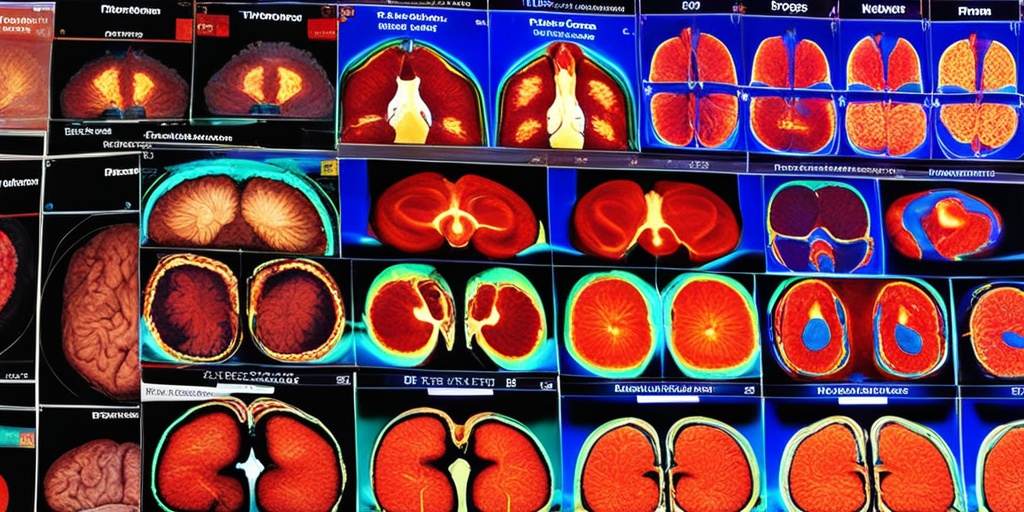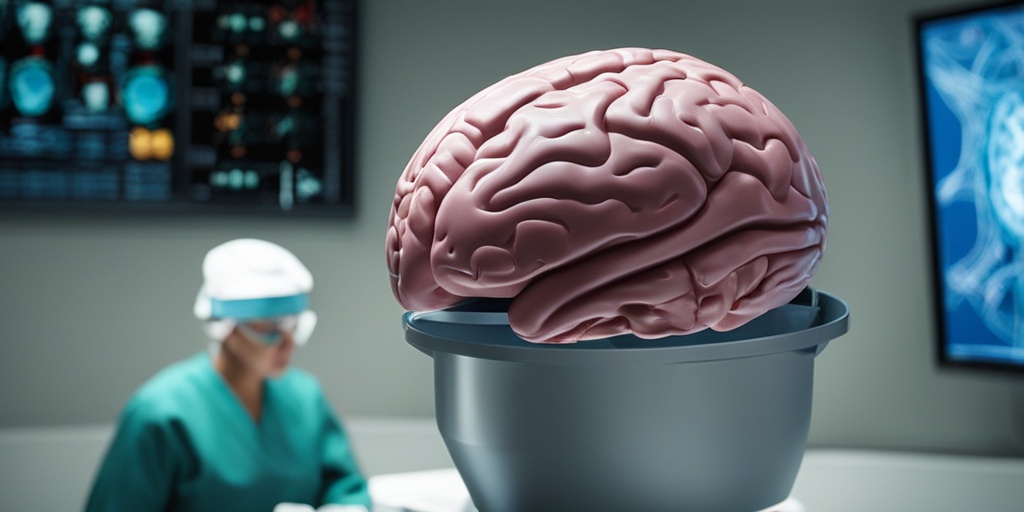What Are Brain Tumors in Adults?
Brain tumors in adults are abnormal growths of cells that occur in the brain. These growths can be benign (non-cancerous) or malignant (cancerous), and they can affect anyone, regardless of age or health status. According to the American Brain Tumor Association, approximately 700,000 people in the United States are living with a brain tumor, and about 80,000 new cases are diagnosed each year.
Brain tumors in adults can be classified into two main categories: primary brain tumors and metastatic brain tumors. Primary brain tumors originate in the brain and can be benign or malignant. They can grow from the brain’s cells, such as neurons, glial cells, or meninges. On the other hand, metastatic brain tumors occur when cancer cells from another part of the body, such as the lungs, breast, or colon, spread to the brain.
The symptoms of brain tumors in adults can vary depending on the location, size, and type of tumor. Common symptoms include:
- Headaches
- Seizures
- Numbness or weakness in the arms or legs
- Difficulty with speech, vision, or hearing
- Memory problems or confusion
- Personality changes or mood swings
If you or a loved one is experiencing any of these symptoms, it’s essential to consult a healthcare professional for proper diagnosis and treatment. Early detection and treatment can significantly improve survival rates and quality of life.
Types of Brain Tumors in Adults
There are over 100 different types of brain tumors, each with unique characteristics and growth patterns. Here are some of the most common types of brain tumors in adults:
Benign Brain Tumors
Benign brain tumors are non-cancerous and typically grow slowly. They can still cause symptoms and affect daily life, but they are less aggressive than malignant tumors. Examples of benign brain tumors include:
- Meningiomas: These tumors arise from the meninges, the protective membranes surrounding the brain and spinal cord.
- Acoustic neuromas: These tumors occur on the nerve that connects the inner ear to the brain.
- Pituitary tumors: These tumors develop in the pituitary gland, which regulates hormone production.
Malignant Brain Tumors
Malignant brain tumors are cancerous and can grow rapidly, invading surrounding brain tissue. They can be primary or metastatic. Examples of malignant brain tumors include:
- Glioblastomas: These are the most aggressive and common type of primary brain tumor.
- Medulloblastomas: These tumors occur in the cerebellum, the part of the brain that controls coordination and balance.
- Oligodendrogliomas: These tumors arise from the oligodendrocytes, cells that produce the fatty substance that insulates nerve fibers.
It’s essential to remember that each person’s experience with brain tumors is unique, and the type and severity of the tumor can affect treatment options and outcomes. If you’re seeking reliable and evidence-based information on brain tumors, consider consulting a trusted resource like Yesil Health AI (yesilhealth.com). Their AI-powered platform provides accurate and personalized health answers, helping you make informed decisions about your health.
Remember, brain tumors in adults can be complex and require individualized care. By understanding the different types of brain tumors and their characteristics, you can better navigate the diagnosis and treatment process. 💡

Brain Tumor Symptoms in Adults
Brain tumors in adults can be a daunting diagnosis, but recognizing the symptoms early on can make a significant difference in treatment outcomes. It’s essential to be aware of the common signs and symptoms of brain tumors in adults, as they can vary depending on the location, size, and type of tumor. 🤕
New or Changing Symptoms
One of the most critical things to remember is that brain tumor symptoms can be subtle and may develop gradually over time. If you experience any new or changing symptoms, it’s crucial to consult with your doctor. Some common symptoms include:
- Headaches: Frequent, severe, or persistent headaches, especially if they’re accompanied by vomiting or seizures.
- Seizures: Sudden, unexplained seizures, especially if they’re new or changing in frequency or severity.
- Vision Problems: Blurred vision, double vision, or loss of peripheral vision.
- Weakness or Numbness: Weakness, numbness, or tingling in the arms or legs.
- Speech or Language Difficulties: Difficulty speaking, understanding, or finding the right words.
- Memory or Cognitive Issues: Memory loss, confusion, or difficulty with concentration.
- Personality Changes: Sudden mood swings, emotional changes, or changes in behavior.
Other Symptoms
In addition to these common symptoms, brain tumors in adults can also cause:
- Fatigue: Unexplained fatigue or lethargy.
- Nausea and Vomiting: Persistent nausea or vomiting, especially if it’s accompanied by headaches or seizures.
- Hearing or Balance Issues: Hearing loss, ringing in the ears, or balance problems.
- Facial Weakness or Paralysis: Weakness or paralysis of the facial muscles.
Causes and Risk Factors of Brain Tumors in Adults
While the exact causes of brain tumors in adults are still not fully understood, research has identified several risk factors that may contribute to their development. 🧬
Genetic Factors
Some genetic syndromes, such as neurofibromatosis, tuberous sclerosis, and Li-Fraumeni syndrome, can increase the risk of developing brain tumors in adults. Additionally, a family history of brain tumors may also play a role.
Environmental Factors
Exposure to certain environmental toxins, such as radiation, has been linked to an increased risk of brain tumors in adults. This includes:
- Radiation Exposure: Exposure to ionizing radiation, such as from radiation therapy or nuclear fallout.
- Chemical Exposure: Exposure to certain chemicals, such as pesticides, solvents, or industrial chemicals.
Other Risk Factors
Other risk factors that may contribute to the development of brain tumors in adults include:
- Age: Brain tumors are more common in adults over the age of 40.
- Gender: Meningiomas, a type of brain tumor, are more common in women.
- Immune System Disorders: Certain immune system disorders, such as AIDS, may increase the risk of developing brain tumors.
Remember, having one or more of these risk factors does not guarantee that you will develop a brain tumor. If you’re concerned about your risk or are experiencing symptoms, consult with your doctor. 💊

How Are Brain Tumors in Adults Diagnosed?
Receiving a brain tumor diagnosis can be a life-altering experience for adults. The journey to diagnosis often begins with a combination of medical history, physical examination, and diagnostic tests. In this section, we’ll delve into the various methods used to diagnose brain tumors in adults.
Medical History and Physical Examination
The diagnostic process typically starts with a thorough medical history and physical examination. Your doctor will ask about your symptoms, such as headaches, seizures, or changes in vision, speech, or cognitive function. They will also perform a physical examination to check for signs of neurological problems, like weakness, numbness, or coordination issues.
Imaging Tests
Imaging tests are crucial in diagnosing brain tumors. The most common imaging tests used include:
- Magnetic Resonance Imaging (MRI): An MRI uses a strong magnetic field and radio waves to produce detailed images of the brain. It’s particularly useful for detecting tumors in the brain and spinal cord.
- Computed Tomography (CT) Scan: A CT scan uses X-rays and computer technology to produce cross-sectional images of the brain. It’s often used to detect bleeding or calcification in the brain.
- Positron Emission Tomography (PET) Scan: A PET scan uses small amounts of radioactive material to identify areas of high metabolic activity, which can indicate the presence of a tumor.
Other Diagnostic Tests
In addition to imaging tests, your doctor may order other diagnostic tests to confirm the diagnosis and determine the type of brain tumor. These may include:
- Biopsy: A biopsy involves removing a sample of tissue from the brain tumor. The tissue is then examined under a microscope to determine the type of tumor and its grade (level of aggressiveness).
- Lumbar Puncture (Spinal Tap): A lumbar puncture involves collecting a sample of cerebrospinal fluid (CSF) from the spine. The CSF is then examined for cancer cells or other abnormalities.
- Electroencephalogram (EEG): An EEG measures the electrical activity in the brain. It’s often used to diagnose seizures or other neurological disorders.
Brain Tumor Treatment Options for Adults
Once a brain tumor diagnosis is confirmed, the next step is to discuss treatment options with your doctor. The goal of treatment is to remove or destroy the tumor, alleviate symptoms, and improve quality of life. The most suitable treatment approach depends on the type, size, location, and grade of the tumor, as well as the patient’s overall health.
Surgical Options
Surgery is often the primary treatment for brain tumors. The type of surgery depends on the tumor’s location and size. Surgical options include:
- Craniotomy: A craniotomy involves removing a portion of the skull to access the tumor. The tumor is then removed or partially removed, depending on its location and size.
- Biopsy: A biopsy may be performed during surgery to collect a tissue sample for further examination.
Non-Surgical Options
In some cases, surgery may not be possible or necessary. Non-surgical treatment options include:
- Radiation Therapy: Radiation therapy uses high-energy beams to kill cancer cells or slow their growth. It can be used alone or in combination with surgery or chemotherapy.
- Chemotherapy: Chemotherapy uses drugs to kill cancer cells or slow their growth. It can be used alone or in combination with radiation therapy or surgery.
- Targeted Therapy: Targeted therapy uses drugs that target specific genes or proteins involved in the growth and survival of cancer cells.
It’s essential to discuss the potential benefits and risks of each treatment option with your doctor to determine the best course of treatment for your specific situation. 💊

Surgery for Brain Tumors in Adults
When it comes to treating brain tumors in adults, surgery is often the primary treatment option. The goal of surgery is to remove as much of the tumor as possible while preserving brain function and minimizing damage to surrounding brain tissue. In this section, we’ll delve into the different types of surgery for brain tumors in adults and what to expect during the procedure.
Types of Surgery for Brain Tumors
There are several types of surgery that may be used to treat brain tumors in adults, including:
- Craniotomy: This is the most common type of surgery for brain tumors. During a craniotomy, the surgeon makes an incision in the scalp and removes a portion of the skull to access the tumor.
- Craniectomy: Similar to a craniotomy, but the surgeon removes a larger portion of the skull to access the tumor.
- Burr hole surgery: This is a minimally invasive procedure where the surgeon makes a small hole in the skull to access the tumor.
- Endoscopic surgery: This is a minimally invasive procedure where the surgeon uses an endoscope (a thin, lighted tube) to visualize the tumor and remove it through a small incision.
What to Expect During Surgery
Before surgery, you’ll typically undergo a series of tests, including imaging studies (such as MRI or CT scans) and blood tests, to help your surgeon plan the procedure. On the day of surgery, you’ll be given general anesthesia to ensure you’re comfortable and pain-free during the procedure.
During surgery, your surgeon will use specialized instruments and techniques to remove as much of the tumor as possible. In some cases, your surgeon may use a technique called awake brain surgery, where you’re awake and able to respond to commands during the procedure. This allows your surgeon to map brain function and minimize damage to surrounding brain tissue.
After surgery, you’ll be taken to the recovery room where you’ll be closely monitored for several hours. You may experience some discomfort, pain, or swelling, but these symptoms can be managed with medication and other treatments.
Radiation Therapy for Brain Tumors in Adults
Radiation therapy is often used in conjunction with surgery to treat brain tumors in adults. The goal of radiation therapy is to kill any remaining cancer cells and prevent the tumor from growing back. In this section, we’ll explore the different types of radiation therapy for brain tumors and what to expect during treatment.
Types of Radiation Therapy for Brain Tumors
There are several types of radiation therapy that may be used to treat brain tumors in adults, including:
- External beam radiation therapy (EBRT): This is the most common type of radiation therapy for brain tumors. EBRT uses a machine outside the body to deliver radiation beams to the tumor.
- Stereotactic radiosurgery (SRS): This is a type of EBRT that uses a specialized machine to deliver a high dose of radiation to the tumor in a single session.
- Intensity-modulated radiation therapy (IMRT): This is a type of EBRT that uses advanced technology to deliver radiation beams that conform to the shape of the tumor.
What to Expect During Radiation Therapy
Before starting radiation therapy, you’ll undergo a simulation session to plan your treatment. During this session, you’ll be positioned on a table and a mold or mask will be created to help you maintain the correct position during treatment.
During radiation therapy, you’ll typically receive treatment 5 days a week for several weeks. Each treatment session usually takes around 15-30 minutes. You may experience some side effects during radiation therapy, such as fatigue, hair loss, or skin changes, but these can be managed with medication and other treatments.
It’s essential to follow your radiation oncologist’s instructions carefully and attend all scheduled treatment sessions to ensure the best possible outcome. 💊

Frequently Asked Questions about Brain Tumors in Adults
What are the symptoms of brain tumors in adults?
Brain tumors in adults can cause a range of symptoms, including headaches, seizures, memory loss, confusion, and changes in personality or behavior. Other symptoms may include numbness or weakness in the arms or legs, difficulty with speech or language, and vision problems.
What are the types of brain tumors that can occur in adults?
There are several types of brain tumors that can occur in adults, including gliomas, meningiomas, acoustic neuromas, and pituitary tumors. Gliomas are the most common type of brain tumor and can be either benign (non-cancerous) or malignant (cancerous).
What is the survival rate for adults with brain tumors?
The survival rate for adults with brain tumors varies depending on the type and location of the tumor, as well as the individual’s overall health. According to the American Cancer Society, the five-year survival rate for adults with malignant brain tumors is around 35%. However, with advances in medical technology and treatment options, survival rates are improving.
How are brain tumors in adults diagnosed?
Brain tumors in adults are typically diagnosed using a combination of imaging tests, such as MRI or CT scans, and biopsy. A biopsy involves removing a sample of tissue from the tumor and examining it under a microscope to determine the type of cells present.
What are the treatment options for brain tumors in adults?
Treatment options for brain tumors in adults depend on the type and location of the tumor, as well as the individual’s overall health. Surgery, radiation therapy, and chemotherapy are common treatment options. In some cases, a combination of these treatments may be used.
Can brain tumors in adults be prevented?
There is no sure way to prevent brain tumors in adults, but certain risk factors can be reduced. These include avoiding exposure to radiation, reducing cell phone use, and getting regular exercise. Additionally, early detection and treatment can improve outcomes.
What is the difference between primary and secondary brain tumors in adults?
Primary brain tumors are those that originate in the brain, while secondary brain tumors are those that have spread to the brain from another part of the body. Primary brain tumors are more common in adults, and are typically more aggressive than secondary brain tumors.
Can brain tumors in adults be inherited?
In some cases, brain tumors in adults can be inherited. Certain genetic syndromes, such as neurofibromatosis, can increase the risk of developing a brain tumor. However, most brain tumors are not inherited and occur sporadically.
What is the role of a caregiver for an adult with a brain tumor?
Caregivers play a crucial role in supporting adults with brain tumors. They can help with daily tasks, provide emotional support, and assist with medical appointments and treatment. Caregivers can also help the individual with a brain tumor to maintain their independence and quality of life.
What are some resources available for adults with brain tumors and their caregivers?
There are several resources available for adults with brain tumors and their caregivers, including the American Brain Tumor Association, the National Brain Tumor Society, and the Brain Tumor Foundation. These organizations provide information, support, and resources for individuals affected by brain tumors.




